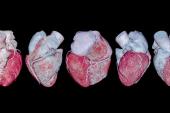DISCHARGE Data Reassure on Use of CCTA in Older Chest-Pain Patients
Guidelines say CCTA may be preferable in younger patients, but this analysis shows its strengths even in the elderly, experts say.

Physicians can confidently send stable chest pain patients of all ages with an intermediate likelihood of CAD, including those older than 75 years, to CT angiography rather than cardiac catheterization without being concerned about the risk of future major cardiovascular events, according to new results from the landmark DISCHARGE trial.
In a prespecified secondary analysis of the trial, age did not modify the effect of the randomization group—an initial diagnostic strategy of CT or invasive coronary angiography—on the primary MACE outcome, but younger patients were less likely to experience procedure-related complications, report investigators this week in JAMA Cardiology.
“I think that’s a very important take-home point—one does not have to fear that older or younger patients during follow-up have more infarctions, more stroke, or more cardiovascular death if they are managed with CT as the initial diagnostic test,” lead investigator Marc Dewey, MD (Charité – Universitätsmedizin Berlin, Germany), told TCTMD.
Published 2 years ago in the New England Journal of Medicine, the main DISCHARGE results showed that there was no significant difference in the risk of MACE between patients initially evaluated with coronary CT angiography (CCTA) compared with invasive coronary angiography over 3.5 years of follow-up. If anything, the risk of MACE was numerically lower with CCTA and procedure-related complications were significantly fewer.
The American College of Cardiology/American Heart Association acute and stable chest pain guidelines give CCTA a class 1 recommendation for excluding atherosclerotic plaque and obstructive CAD in the intermediate-probability patient without known CAD. However, the guidelines also state that the imaging test is preferable in those younger than 65 years while stress testing might be more advantageous in older patients.
To TCTMD, Dewey said the PROMISE trial provided evidence for that recommendation around age, with researchers reporting that a positive CT test in younger patients had more prognostic value for predicting cardiovascular death and MI while functional testing worked better in older adults. Similarly, data from the COME-CCT Consortium published in a 2019 BMJ paper, for which Dewey was senior investigator, showed that the diagnostic performance of CCTA was “slightly lower” in patients older than 75 years. “That, of course, gave us somewhat of a concern and we told ourselves: better look at this,” said Dewey.
It’s a reassurance about accuracy not dropping off in older adults. Marc Dewey
Jonathon Leipsic, MD (University of British Columbia/St. Paul’s Hospital, Canada), who wasn’t involved in the study, said the clinical guidelines “do have a little bit of a bias” toward functional testing in elderly patients.
“I think a lot of that is historic because early days of CT, with older CT scanners and protocols, were more challenged generally by higher burdens of calcification which we see in older patients,” he told TCTMD. “So, I think this is an important analysis. There are many such analyses more recently that would suggest that CT is really quite robust, even in the setting of extensive calcium in older patients.”
No Impact of Age on Primary Outcome
The DISCHARGE analysis was jointly led by Maria Bosserdt, PhD (Charité – Universitätsmedizin Berlin), Lina Serna-Higuita, MD (Universitätsklinikum Tubingen, Germany), and Gudrun Feuchtner, MD (Innsbruck Medical University, Austria), and included 3,561 patients (mean age 60.1 years; 56.2% female) with an intermediate pretest probability of obstructive coronary artery disease. Of these, more than two-thirds were younger than 65 years, 27.6% were aged 65 to 75 years, and 6.1% were older than 75 years. Younger patients were more likely to be male, had a lower pretest probability of disease, and a lower number of cardiovascular risk factors.
With age modeled as a continuous variable, there was no significant interaction between age and the randomization group for MACE or the individual components of the primary endpoint. Age did, however, have an effect on the randomization group for the primary safety endpoint of procedure-related complications. In patients younger than 65 years, major procedure-related complications were lower with an initial strategy of CCTA compared with invasive angiography.
In the main DISCHARGE trial, there was an approximate fourfold reduction in the risk of major procedure-related complications in all patients, but Dewey said this new analysis shows that benefit stems mainly from the reduction in risk in younger patients. In these younger patients, there was a roughly tenfold lower likelihood of procedure-related complications when using CT compared with invasive angiography.
Based on their findings, Dewey believes there is now good evidence to conclude that CCTA should be preferred as the initial strategy not only in those younger than 65 years, but also older patients. He pointed out that in all patients randomized to the CT-first strategy, the proportion of nondiagnostic CT scans was similar across age groups (5.9%, 5.5%, and 4.3% in those < 65 years, 65-75 years, and > 75 years, respectively).
“The nondiagnostic rate of coronary CT, if anything, was slightly lower in older patients,” said Dewey. “But basically, no difference. That had been one of the concerns, that you could have more nondiagnostic [scans] because of more calcification in older patients or challenges in lying flat for 10 minutes, things like that which may have lowered our overall area-under-the-curve in the BMJ paper from 2019. We didn’t see that here so really it’s a reassurance about accuracy not dropping off in older adults.”
Fifteen years ago, people would have said you should never do CT in these [older] patients. . . . I think this reiterates that that’s historic thinking. Jonathon Leipsic
To TCTMD, Leipsic said the DISCHARGE analysis provides yet more evidence that CCTA in stable patients with chest pain should be considered a first-line test, even in older patients. For centers with new CT programs and less clinical experience, older patients might pose a challenge, but the guidelines leave room for those sites to perform functional testing.
“I don't think anyone is saying you should only do CT in these patients, but I think it adds further evidence to reminds us that the guidelines are correct, and that CT is perfectly reasonable,” said Leipsic. “Fifteen years ago, people would have said you should never do CT in these [older] patients. . . I think this reiterates that that’s historic thinking.”
Michael O’Riordan is the Managing Editor for TCTMD. He completed his undergraduate degrees at Queen’s University in Kingston, ON, and…
Read Full BioSources
The DISCHARGE trial group. Age and computed tomography and invasive coronary angiography in stable chest pain. JAMA Cardiol. 2024;Epub ahead of print.
Disclosures
- Dewey reports grants from the European Commission, German Research Foundation, the DFG Priority Programme Radiomics, and Berlin University Alliance. He holds a patent for dynamic perfusion analysis and is the editor of Cardiac CT. He reports research agreements with Siemens, General Electric, Philips, and Canon, all of which are managed by Charité – Universitätsmedizin Berlin.





Comments